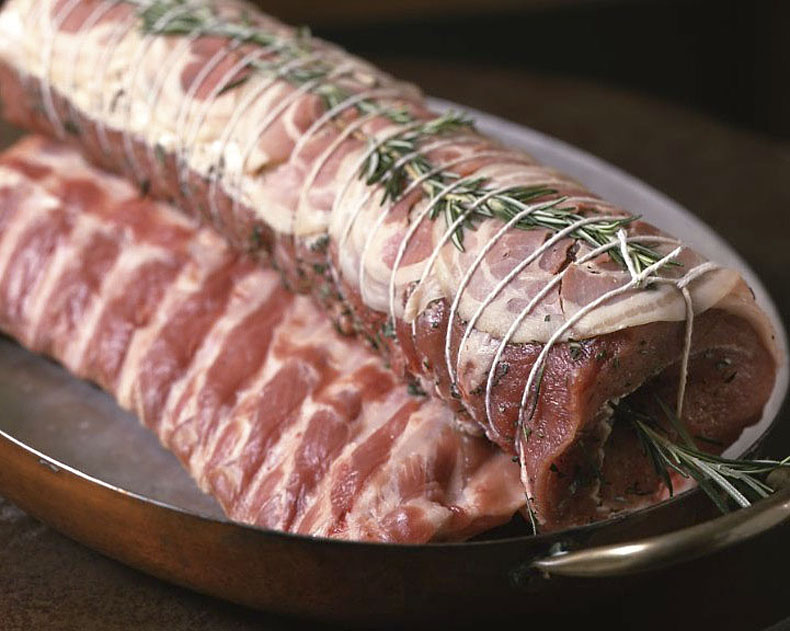Herb-Scented Tuscan Pork Roast has been one of my most popular recipes over the years. I learned it while hanging out with my friend Peggy Markel during one of the Culinary Adventures she regularly leads in Tuscany. Peggy learned the recipe from chef Piero Ferrini (and so it goes, recipes passed on from cook to cook, making their way in the world, evolving as they go.) This recipe is easy to make, never fails to get raves, and is delicious cold. And it is also full of improvisational ideas you can apply to other foods. The pork loin is seasoned with rosemary and sage, herbs that are at the heart of Tuscan cooking. They are chopped together with garlic and salt to make Tuscan Herb Salt, a fabulously aromatic rub.
The Herb Salt itself is wonderful on just about any roast, from lamb and beef to chicken, as well as on vegetables, on bruschetta and in eggs (click here for more ideas).
The basic technique of wrapping meat with pancetta or bacon to keep it moist while roasting or rotisserie-ing is a great one. I’ve used it to season and baste all sorts of lean roasts: two pork tenderloins (placed thick end to thin end and lashed together); turkey tenderloins or breasts; chickens, venison, Guinea hens and other game birds. While pancetta has a more neutral peppery flavored, bacon will give the meat a smoky flavor.
I also love the trick of lashing herbs onto the outside of a roast with string. The herbs dry out and smoke, perfuming the roast with their flavor.

Herb-Scented Tuscan Pork Roast
This is a wonderful dinner party dish because it takes so little work for such a dramatic effect. Peggy buys a whole bone-in loin and has the butcher remove the rib bones in one piece and uses them as a rack on which she roasts the loin, to add flavor to the meat and pan juices. If you have the butcher cut through the chine bone, you can easily cut the delectable ribs apart to nibble on. Alternatively, you can simply roast a 4 1/2 -pound boneless pork loin on a wire rack. (If you want the bonus of roasted ribs, you can always buy a separate rack of ribs.)
Serves 8
One 7-pound pork loin, fat trimmed and boned by your butcher (bones reserved) OR a 4 1/2 -pound boneless pork loin
Tuscan Herb Salt (below)
Four long rosemary branches, about 10-inches long
1 1/2 teaspoons coarse salt
4 to 5 thin slices pancetta (Italian rolled, unsmoked bacon)
1 teaspoon olive oil
2 cups dry white wine
Pat the pork loin dry. Using a knife sharpening steel or a long-handled wooden spoon pierce a hole lengthwise through the center. Working at each end of the loin, use your fingers to stuff all but 1 tablespoon of the Herb Salt into the hole. Then insert 1 of the rosemary branches into each end so that it forms a tassle. Mix the remaining Herb Salt with the coarse salt and rub it all over the roast.
Arrange the pancetta slices, slightly overlapping each other, down the length of the roast. Arrange the 2 remaining rosemary sprigs on top. Tie the roast like a sausage at 1-inch intervals with cotton string to give it a neat shape. Transfer to a platter, cover with plastic wrap and refrigerate for at least 2 hours and up to 24 hours. Bring to room temperature 1 hour before roasting.
Preheat the oven to 450’. Place the rack of rib bones curved side down in a shallow roasting pan. Pat the roast dry with paper towels and rub with the olive oil. Place the roast on the rack and roast for 15 minutes. Remove the pan from the oven, turn the roast over and baste with a few tablespoons of the wine. Return the roast to the oven and reduce the temperature to 350’. Cook for 1 1/4 to 1 1/2 hours, turning the roast and basting it with wine every 20 minutes; reserve 1/2 cup of wine for the sauce. The roast is done when an instant-read thermometer inserted in the center registers 145’.
Transfer the roast to a platter and pour the pan juices into a measuring cup. If the meat on the rack of bones is still pink and you wish to serve the ribs, place on a baking sheet and return to the oven for about 15 minutes.
Meanwhile, place the roasting pan over 2 burners on moderate heat; when it starts to sizzle, add the reserved 1/2 cup wine and cook for 2 minutes, scraping up the drippings from the bottom of the pan. Add to the pan juices in the measuring cup; let the fat rise to the surface, 5 minutes. Skim off the fat and season the sauce with salt and pepper.
Remove the strings and carve the roast into thin slices. If serving the ribs, remove the rack from the pan and cut through the ribs. Arrange the meat and ribs on a platter and serve the pan juices on the side.
Recipe/Method: Tuscan Herb Salt
Use this fragrant herb salt to season all kinds of roasts, from pork to chicken and to flavor sautéed or roasted vegetables and eggs. This makes about 1/4 cup, enough to season the roast above. To make in larger quantities in a food processor or by hand, click here for detailed instructions. You can watch a video of Sally making it here.
1 garlic clove, peeled
1 tablespoon coarse (Kosher) salt
1 small bunch sage (about 30 leaves)
2 sprigs rosemary
On a cutting board, minced the garlic with the salt. Place the herbs in a mound and coarsely chop them. Add the garlic salt and chop them together to make a coarse rub. If you’re not going to use it right away, spread it out on a plate and leave in the open air to dry. It will keep indefinitely.





Good recipe, the wine in the photo seems a French one, if it is why not to try Palazzo d’Altesi a very Tuscan one from the Montalcino region?
It was definitely not a French wine…but a Tuscan one. Appreciate your suggestion though.
Sally,
I hope you are rejuvenating during your much deserved time away from IL. It wasn’t obvious to me how to email you through the site, so I am leaving this message as a comment to your pork roast recipe. It was the closest post I could find to let you know about how your recipe for Close-Roasted Meat from The Improvisational Cook led me to a very satisfying improv tonight. I’ve used the technique before, and have been so thrilled with the results–silky, soft meat, a house redolent with the scent of garlic and roasting pork, an abundance of leftovers. Now that colder weather has arrived, I’d been thinking about pulling out my Le Creuset and using your method on a pork shoulder. Then I got one of those daily, and sometime annoying, emails from Bon Appetit. The subject–a gochujang flavored pork steak. It seemed a bit fussy and not likely to achieve the fusion of flavor that elevates pork, so I thought how could I rif a bit? I used the basic marinade formula from BA of gochujang, mirin, sake, a bit of soy, tons of garlic and some coins of ginger. I soaked the pork in that spicy bath about 24 hours, then used your Close-Roasted Meat method. You can imagine the results–a rich melding of pork with a just spicy enough sauce. Rice made an excellent sponge for the red, perky sauce (after much skimming of fat), along with roasted winter squash for a complementary hit of sweetness. I’ve turned again to The Improvisational Cook for leftover strategies. I’m thinking corn pancakes. . . . Thanks again for giving me inspiration with your cooking methods. Stay well and rest up.
Louisa, THANK YOU SO MUCH for your detailed comment about the “close-roasting” method I delve into in The Improvisational Cook. It’s curious that lately I’ve been getting a lot of feedback about that very method. I hope to use your comment in a post about it. It’s so glad to hear it inspires improvisation.